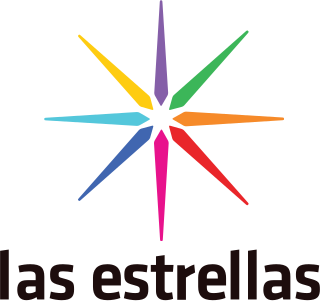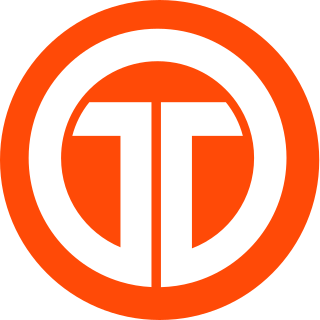UniMás is an American Spanish-language free-to-air television network owned by TelevisaUnivision. The network's programming, which is aimed at Hispanic Americans in the 18-34 age range, includes telenovelas and other serialized drama series, sports, sitcoms, reruns of imported series previously aired on parent network Univision, reality and variety series, and theatrically released feature films.

Televisión Nacional de Chile (TVN) is a Chilean public service broadcaster. It was founded by order of President Eduardo Frei Montalva and it was launched nationwide on 18 September 1969. Since then, the company has been reorganized on several occasions and its operations areas have increased over the years, becoming one of the leading television broadcaster in Chile and South America. The law 17 377 of 1970 established that TVN must be a public, autonomous, pluralistic and representative public service. TVN's public mission determines the obligation to promote the national cultural identity, the values of democracy, human rights, care for the environment and respect for diversity. Furthermore, Televisión Nacional governs the programming of its services according to criteria established by the National Television Council (CNTV).
8TV , formerly known as TD8 and then Citytv, is a Catalan language private TV station based in Barcelona, Spain. The channel is run by OC 2022.
Free-to-air (FTA) services are television (TV) and radio services broadcast in unencrypted form, allowing any person with the appropriate receiving equipment to receive the signal and view or listen to the content without requiring a subscription, other ongoing cost, or one-off fee. In the traditional sense, this is carried on terrestrial radio signals and received with an antenna.

Caracol Televisión is a Colombian free-to-air television network owned by Caracol Medios, a unit of Grupo Valorem. It is one of the leading private TV networks in Colombia, alongside Canal RCN and Canal 1. The network distributes and produces 5,000+ programs and has aired in more than 80 countries.

RCN Televisión, branded as Canal RCN is a Colombian free-to-air television network. It is a Colombian open television channel, belonging to the Ardila Lülle Organization. It was founded as a television content production company on March 23, 1967, and found its broadcasts as an independent channel on July 10, 1998. Its main shareholder is Carlos Ardila Lülle. It produced Yo soy Betty, la fea, one of the most successful Colombian telenovelas.

Radio Caracas Televisión (RCTV) was a Venezuelan free-to-air television network headquartered in the Caracas neighborhood of Quinta Crespo. It was sometimes referred to as the Canal de Bárcenas. Owned by Empresas 1BC, Radio Caracas Televisión (RCTV) was inaugurated on 15 November 1953 by William H. Phelps, Jr. Its radio counterpart was Radio Caracas Radio.
Television in Bulgaria was introduced in 1959. Global players such as News Corporation, Modern Times Group, Central European Media Enterprises, Fox Broadcasting Company and others operate the biggest and most popular media outlets in the country.

Telemundo is an American Spanish-language terrestrial television network owned by NBCUniversal Telemundo Enterprises, a division of NBCUniversal, which in turn is a wholly owned subsidiary of Comcast. It provides content nationally with programming syndicated worldwide to more than 100 countries in over 35 languages.

Television in Colombia or Colombian television is a media of Colombia. It is characterized for broadcasting telenovelas, series, game shows and TV news. Until 1998 it was a state monopoly. There are two privately owned TV networks and three state-owned TV networks with national coverage, as well as six regional TV networks and dozens of local TV stations. There are numerous cable TV companies operating in Colombia under each Colombian department statutes. These cable companies also develop their own channels, in addition to a variety of international channels. Television in Colombia has always relied on technological advancements from developed countries importing almost all the equipment.

Television is a popular form of entertainment in Mexico, with mass entertainment playing an important role in creating a national, unified culture. The telenovelas are very traditional in Mexico and are translated to many languages and seen all over the world with renowned names like Lucero, Thalía, Verónica Castro, Itati, Leticia Calderón and Victoria Ruffo.
FETV is a television network that broadcasts on channel 5 in Panama City, and is headquartered in Panama City, Panama, with repeaters throughout the country. The network and stations broadcast in the NTSC format. The network takes its name from the Television Education Foundation (FETV), its owner.
Television in Poland was introduced in 1937. It was state owned, and was interrupted by the Second World War in 1939. Television returned to Poland in 1952 and for several decades was controlled by the communist government. Colour television was introduced in Poland in 1971. Private television stations in Poland appeared around the time of the fall of communism, with PTV Echo becoming the first private station in Poland.

Las Estrellas is one of the cornerstone networks of TelevisaUnivision, with affiliate stations all over Mexico, flagshipped at XEW-TDT in Mexico City. Many of the programs of Las Estrellas are seen in the United States on Univision, UniMás, and Galavisión.

A telenovela is a type of a television serial drama or soap opera produced primarily in Latin America. The word combines tele and novela. Similar drama genres around the world include teleserye (Philippines), lakorn (Thailand), téléroman, and sinetron (Indonesia).

24 horas is the brand that identifies the gathering and broadcasting of news in the Chilean public broadcaster Televisión Nacional de Chile. It started as an informative program of the same television network on 1 October 1990. Then in 2009 it became a television channel called Canal 24 horas.

Telemetro is a television network headquartered in Panama City, Panama, with repeaters throughout the country. The station broadcasts in NTSC format and in Panama City also in DVB-T format. In 1996 Telemetro and RPC TV merged and formed Corporacion Medcom.
The Sistema Estatal de Radio y Televisión, is the public broadcaster of Panama. It operates three radio networks and the Sertv national television network, broadcast on channel 11 in Panama City.
NEX is a private Panamanian broadcaster based in Panama City. It broadcasts in Panama City on analog UHF channel 21 and channel 49 in DVB-T, with several repeaters across Panama. It is owned by Compañía Digital de TV.











